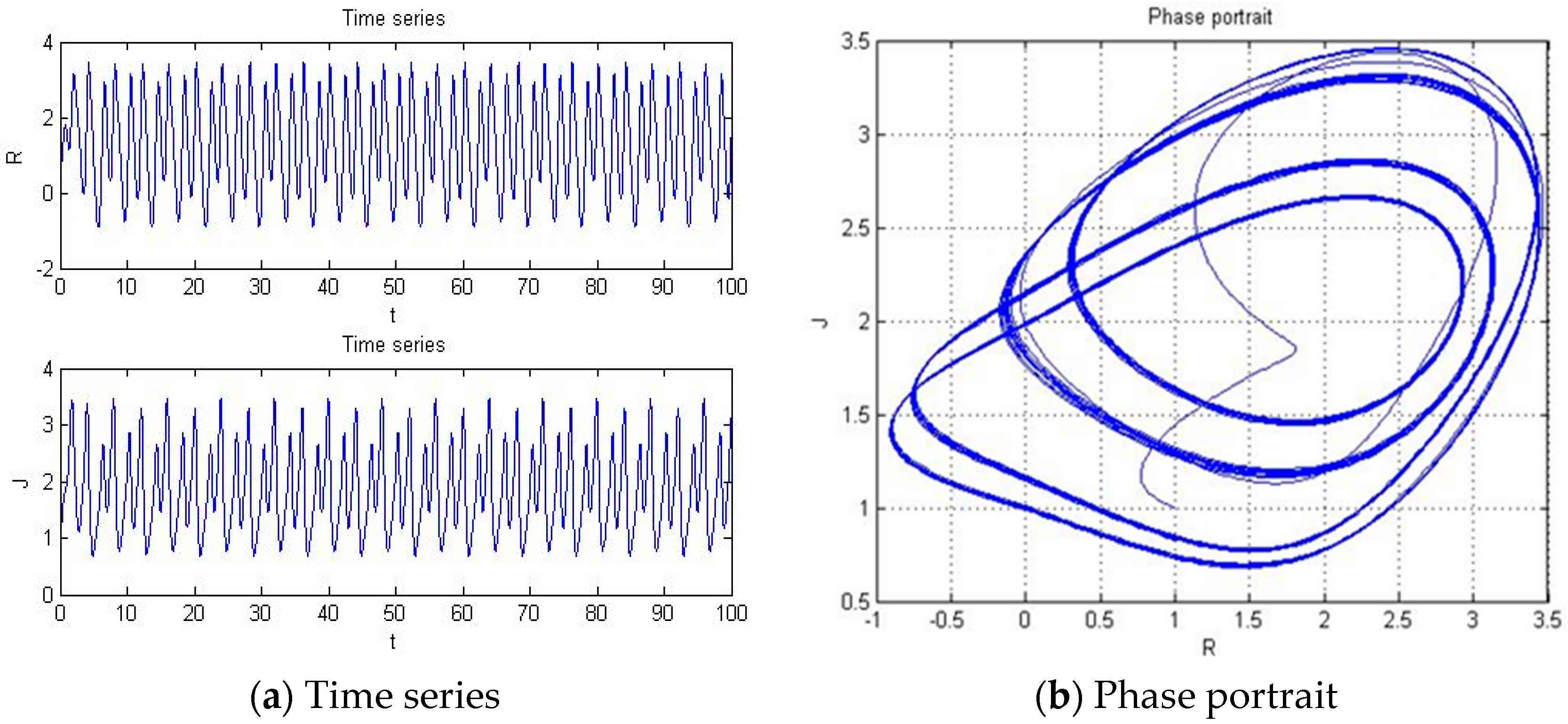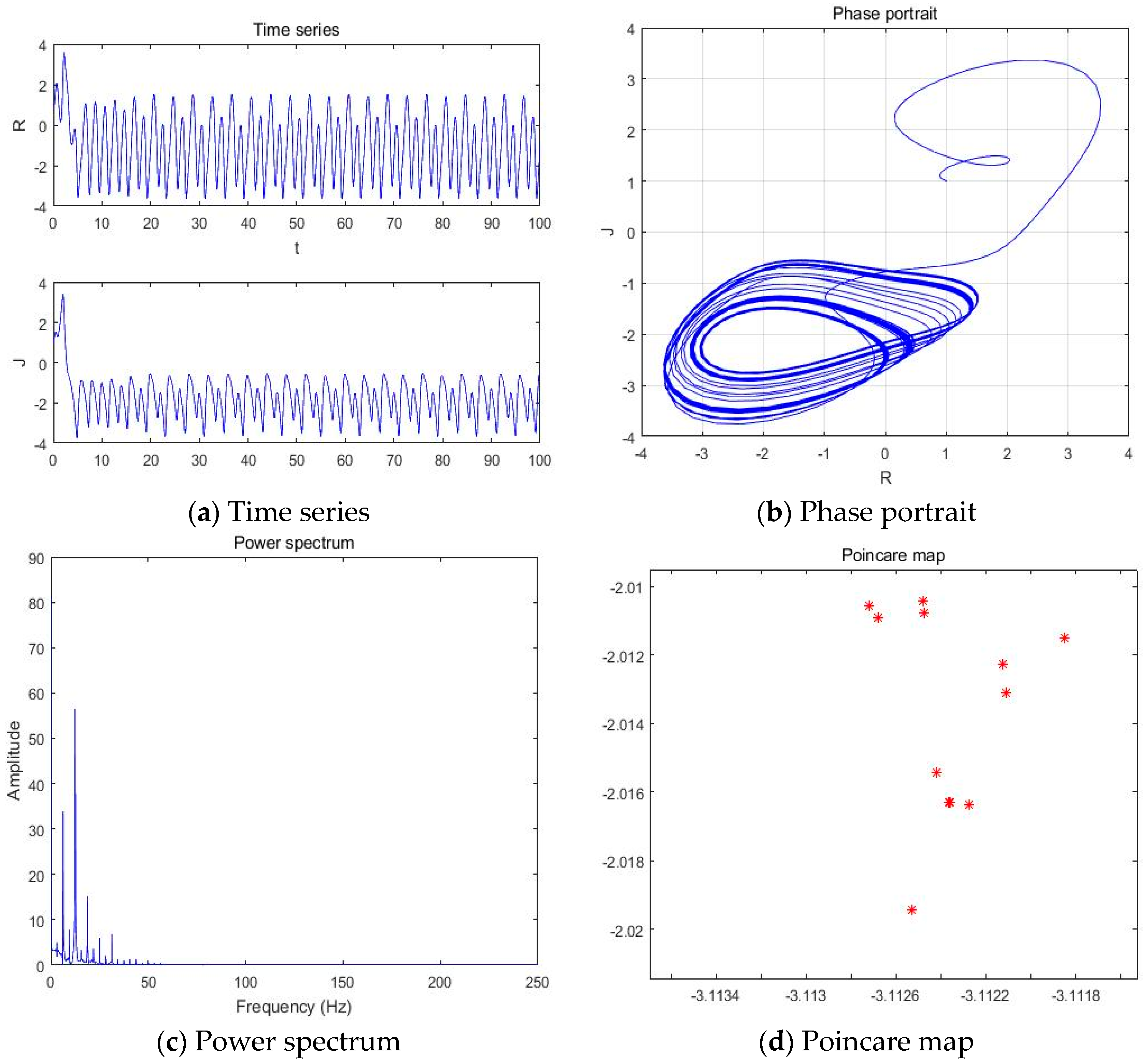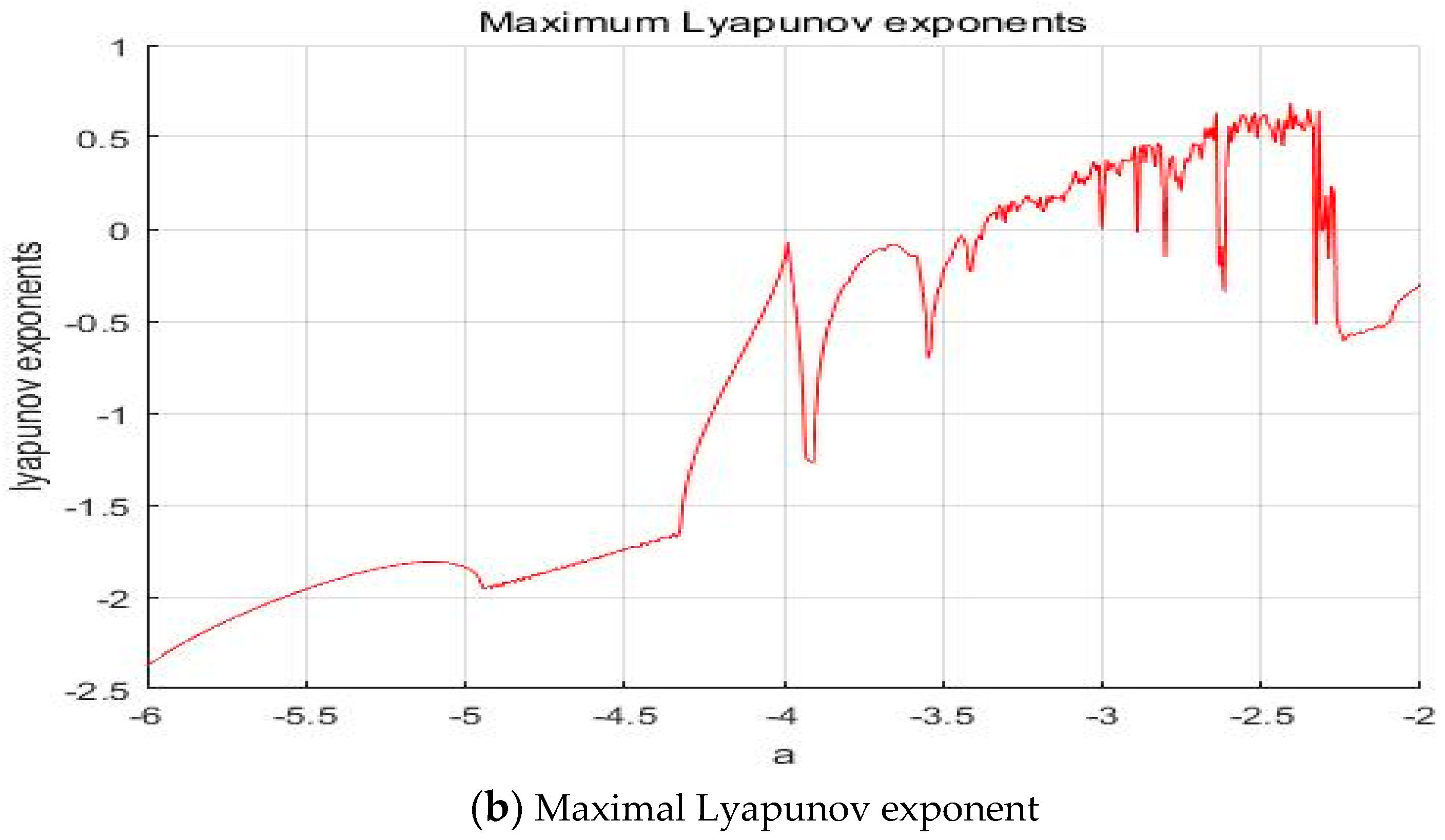Analysis of Chaotic Behavior in a Novel Extended Love Model Considering Positive and Negative External Environment
Abstract
:1. Introduction
2. Love Model of Romeo and Juliet
2.1. Basic Love Model of Romeo and Juliet
2.2. Nonlinear Love Model
2.3. Extended Love Model with an External Environment
2.4. Extended Love Model with a Positive and Negative External Environment
3. Setting of Range of Parameter Value
3.1. Condition of System’s Parameter Range
3.2. Condition of External Environment Parameter
4. Chaotic Behavior in the Extended Love Model with a Positive and Negative External Environment
4.1. When b = −2, c = 1, d = 1, y(t) = 5sin(πt)
4.1.1. a = −5.41
4.1.2. a = −3.451
4.1.3. a = −3.406
4.1.4. a = −3.201
4.1.5. a = −2.561
4.2. When b = −2, c = 1, d = 1, y(t) = 6sin(πt) + 1
4.2.1. a = −5.41
4.2.2. a = −3.451
4.2.3. a = −3.406
4.2.4. a = −3.201
4.2.5. a = −2.561
4.3. When b = −2, c = 1, d = 1, y(t) = 6sin(πt) − 1
4.3.1. a = −5.41
4.3.2. a = −3.451
4.3.3. a = −3.406
4.3.4. a = −3.201
4.3.5. a = −2.561
5. Conclusions
Author Contributions
Acknowledgments
Conflicts of Interest
References
- Strogatz, S.H. Nonlinear Dynamics and Chaos: With Application to Physics, Biology, Chemistry and Engineering; Addison-Wesley: Reading, MA, USA, 1994. [Google Scholar]
- Berezowski, M.; Dubaj, D. Chaotic oscillations of coupled chemical reactors. Chaos Solitons Fractals 2015, 78, 22–25. [Google Scholar] [CrossRef]
- Shon, Y.W. The Pattern Recognition System Using the Fractal Dimension of Chaos Theory. Int. J. Fuzzy Log. Intell. Syst. 2015, 15, 121–125. [Google Scholar] [CrossRef]
- Kim, J.S.; Chung, J.Y. Development of Efficient Encryption Scheme on Brain-Waves Using Five Phase Chaos Maps. Int. J. Fuzzy Log. Intell. Syst. 2016, 16, 59–63. [Google Scholar] [CrossRef]
- Landi, P.; Dercole, F. The social diversification of fashion. J. Math. Sociol. 2016, 40, 185–205. [Google Scholar] [CrossRef] [Green Version]
- Guastello, S.J. Nonlinear dynamics in psychology. Discrete Dyn. Nat. Soc. 2001, 6, 11–29. [Google Scholar] [CrossRef]
- Smith, B.W. Chaotic family dynamics. Arch. Fam. Med. 1994, 3, 8–123. [Google Scholar] [CrossRef]
- Bae, Y. Chaotic Phenomena in Addiction Model for Digital Leisure. Int. J. Fuzzy Log. Intell. Syst. 2013, 13, 291–297. [Google Scholar] [CrossRef]
- Kim, M.; Bae, Y. Mathematical Modelling and Chaotic Behavior Analysis of Cyber Addiction. J. Korean Inst. Intell. Syst. 2014, 24, 245–250. [Google Scholar] [CrossRef]
- Bae, Y. Mathematical Modelling and Behavior Analysis of Addiction of Physical Exercise. J. Korean Inst. Intell. Syst. 2014, 24, 615–621. [Google Scholar] [CrossRef]
- Bae, Y. Chaotic Dynamics in Tobacco’s Addiction Model. Int. J. Fuzzy Log. Intell. Syst. 2014, 14, 322–331. [Google Scholar] [CrossRef]
- Bae, Y. Analysis of Nonlinear Behavior for Addiction in Digital Leisure. Korean Inst. Electron. Commun. Sci. 2017, 13, 291–297. [Google Scholar]
- Sprott, J.C. Dynamics of Model of Love and Happiness; Chaos and Complex Systems Seminar; University of Wisconsin: Madison, WI, USA, 2001. [Google Scholar]
- Sprott, J.C. Dynamical model of happiness. Nonlinear Dyn. Psychol. Life Sci. 2005, 9, 23–34. [Google Scholar]
- Kim, S.; Choi, S.; Bae, Y.; Park, Y. Mathematical Modelling of Happiness and its nonlinear Analysis. Korean Inst. Electron. Commun. Sci. 2013, 9, 711–717. [Google Scholar] [CrossRef]
- Bae, Y. Synchronization of Dynamical Happiness Model. Int. J. Fuzzy Log. Intell. Syst. 2014, 14, 91–97. [Google Scholar] [CrossRef]
- Sprott, J.C. Dynamics Model of Love; Chaos and Complex Systems Seminar; University of Wisconsin Madison: Madison, WI, USA, 2001. [Google Scholar]
- Strogatz, S.H. Love affairs and differential equations. Math. Mag. 1988, 61. [Google Scholar] [CrossRef]
- Wauer, J.; Schwarzer, D.; Cai, G.Q.; Lin, Y.K. Dynamical models of love with time-varying fluctuations. Appl. Math. Comput. 2007, 188, 1535–1548. [Google Scholar] [CrossRef]
- Son, W.S.; Park, Y.J. Time delay effect on the love dynamical model. Korean Phys. Soc. 2011, 59, 2197–2204. [Google Scholar] [CrossRef]
- Rinaldi, S.; Gragnani, A. Love dynamics between secure individuals: A modelling approach. Nonlinear Dyn. Psychol. Life Sci. 1998, 2, 283–301. [Google Scholar] [CrossRef]
- Gragnani, A.; Rinaldi, S.; Feichtinger, G. Cyclic Dynamics in Romantic Relationships. Int. J. Bifurc. Chaos 1997, 7, 2611. [Google Scholar] [CrossRef]
- Rinaldi, S.; Della, F.; Rossa, F. Dercole, Love and Appeal in Standard Couples. Int. J. Bifurc. Chaos 2010, 20, 2443. [Google Scholar] [CrossRef]
- Huang, L.Y.; Bae, Y. Behavior Analysis in Love Model of Romeo and Juliet with Time Delay. J. Korean Inst. Intell. Syst. 2015, 25, 155–160. [Google Scholar] [CrossRef]
- Huang, L.Y.; Bae, Y. Comparative Behavior Analysis in Love Model with Same and Different Time Delay. Korean J. Korean Inst. Intell. Syst. 2015, 25, 210–216. [Google Scholar] [CrossRef]
- Rinaldi, S. Laura and Petrarch, An Intriguing Case of Cyclical Love Dynamics. SIAM J. Appl. Math. 1998, 58, 1205–1221. [Google Scholar] [CrossRef]
- Cress, C.W. Mathematics and Sex; Griffin Press: Sydney, Australia, 2003. [Google Scholar]
- Austen, J. Pride and Prejudice; Egerton, T., Ed.; Whitehall: London, UK, 1813. [Google Scholar]
- Rinaldi, S.; Rossa, F.D.; Landi, P. A mathematical model of 'Pride and Prejudice. Nonlinear Dyn. Psychol. Life Sci. 2014, 18, 199–211. Available online: http://pure.iiasa.ac.at/10768 (accessed on 15 January 2016).
- Dercole, F.; Rinaldi, S. Love stories can be unpredictable: Jules et Jim in the vortex of life. Chaos Interdiscip. J. Nonlinear Sci. 2014, 24, 023134. [Google Scholar] [CrossRef] [PubMed] [Green Version]
- Rinaldi, S.; Rossa, F.D.; Landi, P. A mathematical model of “Gone with the Wind”. Phys. A Stat. Mech. Appl. 2013, 392, 3231–3239. [Google Scholar] [CrossRef]
- Rinaldi, S.; Landi, P.; Rossa, F.D. Small discoveries can have great consequences in love affairs: The case of “Beauty and The Beast”. Int. J. Bifurc. Chaos 2013, 23, 1330038. [Google Scholar] [CrossRef]
- Rinaldi, S.; Landi, P.; Rossa, F.D. Temporary Bluffing Can Be Rewarding in Social Systems: The Case of Romantic Relationships. J. Math. Sociol. 2015, 39, 203–220. [Google Scholar] [CrossRef] [Green Version]
- Huang, L.Y.; Bae, Y. Nonlinear phenomena in love model using Fourier series of sine wave as external force. J. Korean Inst. Intell. Syst. 2017, 27, 321–327. [Google Scholar]
- Huang, L.Y.; Bae, Y. Periodic doubling and chaotic attractor in the love model with a Fourier series function as external force. Int. J. Fuzzy Log. Intell. Syst. 2017, 17, 17–25. [Google Scholar] [CrossRef]
- Bae, Y. Nonlinear behavior in love model with discontinuous external force. Int. J. Fuzzy Log. Intell. Syst. 2016, 16, 64–71. [Google Scholar] [CrossRef]
- Bae, Y. Analysis of Nonlinear Behavior in Love Model as External Force with Gaussian Fuzzy Membership Function. J. Korean Inst. Intell. Syst. 2017, 27, 29–34. [Google Scholar] [CrossRef]
- Bae, Y. Nonlinear Analysis in Love Dynamics with Triangular Membership Function as External Force. J. Digit. Contents Soc. 2017, 18, 151–159. [Google Scholar] [CrossRef]
- Huang, L.Y.; Bae, Y. Nonlinear Behavior in Romeo and Juliet’s Love model Influenced by External Force with Fuzzy Membership Function. Int. J. Fuzzy Syst. 2017, 16, 64–71. [Google Scholar] [CrossRef]
- Huang, L.Y.; Bae, Y. Chaotic dynamics of the fractional-love model with external environment. Entropy 2018, 20, 53. [Google Scholar] [CrossRef]
- Huang, L.Y.; Hwang, S.S.; Bae, Y. Chaotic Behavior in Model with a Gaussian Function as External Force. Int. J. Fuzzy Log. Intell. Syst. 2016, 16, 262–269. [Google Scholar] [CrossRef]
- Rinaldi, S.; Rossa, F.D.; Dercole, F.; Gragnani, A.; Landi, P. Modelling Love Dynamics; World Scientific: Singapore, 2016. [Google Scholar]



























© 2018 by the authors. Licensee MDPI, Basel, Switzerland. This article is an open access article distributed under the terms and conditions of the Creative Commons Attribution (CC BY) license (http://creativecommons.org/licenses/by/4.0/).
Share and Cite
Huang, L.; Bae, Y. Analysis of Chaotic Behavior in a Novel Extended Love Model Considering Positive and Negative External Environment. Entropy 2018, 20, 365. https://doi.org/10.3390/e20050365
Huang L, Bae Y. Analysis of Chaotic Behavior in a Novel Extended Love Model Considering Positive and Negative External Environment. Entropy. 2018; 20(5):365. https://doi.org/10.3390/e20050365
Chicago/Turabian StyleHuang, Linyun, and Youngchul Bae. 2018. "Analysis of Chaotic Behavior in a Novel Extended Love Model Considering Positive and Negative External Environment" Entropy 20, no. 5: 365. https://doi.org/10.3390/e20050365
APA StyleHuang, L., & Bae, Y. (2018). Analysis of Chaotic Behavior in a Novel Extended Love Model Considering Positive and Negative External Environment. Entropy, 20(5), 365. https://doi.org/10.3390/e20050365





